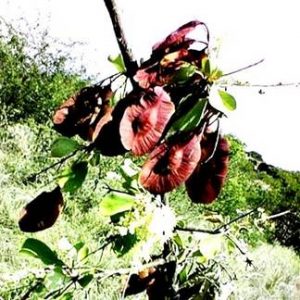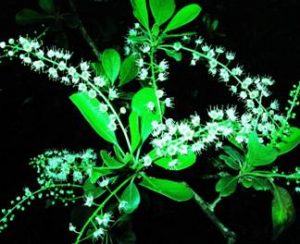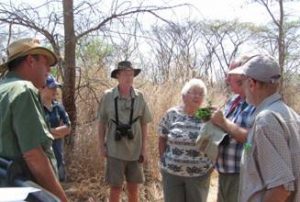TREE LIFE
December 2014
The year has rushed by once again – where did it all go? – so this is the last edition of Tree Life for 2014. The Committee wishes all members a very happy Festive Season and a peaceful, positive New Year.
– Ed
MASHONALAND CALENDAR
Tuesday Dec 2nd : Botanic Gardens Walk with Tom Muller: Meet at 4.45pm in the car park of the Harare Botanic Gardens.
Sunday Dec 7th: Christmas Social at Val d’Or, Ruwa: Our venue again this year is Bill Clarke’s property, Val d’Or; thanks go to Bill for agreeing to host us.
We will serve tea from 9.30 am. After that, we will have a botanical walk and that will be followed by our ever-popular general knowledge quiz, which has again been compiled by Adele Hamilton-Ritchie.
Please bring some Christmas fare to share for tea, and bring your own lunch, a wine glass and a chair. The Society will provide some wine for those attending.
Saturday Dec. 20th (4th Sat.) No outing.
VISIT TO CATAPU NEXT YEAR
This is to let everyone know that my son Tony in the UK thinks it would be quite nice to visit his mother for her birthday next year and take her to Kruger for a few days. However he wants to come when his wife, who works in a school, can also come and that unfortunately is March 28 to April 13, which is right over the time we are planning the Tree Society trip to Catapu. It is still quite far into the future but I hope it wont be a problem if I change the dates of the visit to May 2 to May 9 before I make the final decision. I have also written and asked him if he would consider later in the year.
If there is anyone who is planning to come on the trip and would have a problem with the new dates please let me know.
– Meg Coates Palgrave megcp@zol.co.zw
TREE OF THE MONTH
Terminalia prunioides
Family: – Combretaceae
Common names: Purple-pod Terminalia;
Nd: Ivikane; Sh: Muchanana.
Etymology: The genus name Terminalia depicts the fact that the leaves of Terminalia grow in terminal rosettes, prunioides refers to the plum coloured pods.

Terminalia prunioides pods
Terminalia prunioides likes low-altitude woodlands and bushveld along the Zambezi. Should you visit the long channel of Inner harbour, between Binga and the Sebungwe Narrows on Lake Kariba, you can come across some beautiful, practically pure, stands of T. prunioides, together with some T. stuhlmannii, the zig-zag Terminalia.
This is not a big tree, it usually grows to around 4 m high but I believe that under very good conditions it can reach 13 m.

Terminalia prunioides bark
The bark is brown to grey, rough, vertically striated to fluted and fibrous. Even though the branches can follow a normal pattern they can also be long, thin, drooping and tangled, giving a creeper impression.
The leaves are clustered in rosettes at the ends of dwarf spur-branchlets, obovate to obovate-elliptic, usually 2 to 7 by 1.5 to 3 cm, thinly textured, dark green above, paler below, often with short soft hairs when young, losing most of these by maturity. The margin is entire and fringed with hair, the apex is round and notched. There are 3 to 7 pairs of lateral veins slightly indented above. The petiole is very short, to nearly absent.

Terminalia prunioides flowers
The flowers are white or cream and like most of the other species in the genus, they have an unpleasant smell, but they grow in attractive slender axillary spikes 4-8 cm long, clustered at the tips of the dwarf branchlets (Oct.-Jan., occasionally later).
The fruit is striking, 4 – 6 by 2 – 3 cm, bright plum-red or purple-red, making the trees conspicuous in autumn and winter (Jan.-Jul.).
As the tree does not grow very big, the wood has no commercial value, it is nevertheless hard and tough and has been used in hut construction and to make implement handles. The plant is browsed by game but does not appear to be used medicinally.
Sources:
Coates Palgrave, K. 1977. Trees of Southern Africa . Struik, Cape Town.
Plant Resources of Tropical Africa (PROTA) – www.prota4u.info
PlantzAfrica – Website of the South African Botanical Institute. www.plantzafrica.com
Van Wyk, B. and Van Wyk, P. 1997. Field Guide to the Trees of Southern Africa . Struik, Cape Town.
Mier, P. 2012. Terminalia prunoides www.ispot.org.za
Photographs: JP Felu.
– J.P. Felu
OUTING TO MOUNTAIN VIEW FARM BINDURA 19th OCTOBER 2014
Those of you who went wining and dining on Sunday 19th October missed a very good and interesting visit to Tim and Ruth Kilner’s farm just outside Bindura. Six of us gathered at the pre-arranged meeting place and set off…. on time !!! Isla had suggested that we travel via Domboshawa, Makumbe Mission and Trojan Nickel Mine and what a lovely drive it turned out to be. The countryside looking beautiful and fresh after the recent rain with Brachystegia glaucescens and Julbernardia globiflora flushing and Brachystegia boemhii flowering. And of course the spectacular rock formations in that area which is well watered – all the many small rivers which lead into the Pote and Mazowe are still with water.
We were given an enthusiastic welcome by the Kilner family including a pack of 6-8 curly-tailed dogs, various chickens who really wanted to be part of the party and a couple of old horses who take up residence on the veranda when the weather is hot. After a quick pit stop we set off with Tim and Rebecca across the farm. Mountain View Farm lies 10km North of Bindura on the Mount Darwin road and has been farmed on and off since 1910. It is 1300 ha, of which only 200 ha are arable. The altitude is 1030m, 500m lower than Harare. There are various community development projects happening on the farm now, but no serious cropping. Being October, weather conditions were very hot and very dry.
First impressions did not auger well for a many species count. The old cultivated lands were inhabited mainly by Acacia polyacantha with its hooked thorns and white trunk and white spikey flowers – an invader of disturbed areas and not sought after even for firewood because it burns so hot and fast. We also noted Albizia versicolor which is a low altitude Albizia – Poison pod Albizia. The pods are toxic to cattle but the seeds are eaten by brown headed parrots! Also common was Dichrostachys cinerea – Sickle bush – which is also often invasive and thicket forming, particularly in overgrazed areas. Their most attractive curly or twisted pods are much sort after by game and stock.
At the beginning of our walk we came across Combretum adenogonium – Four leaved Bush Willow – which occur with their four winged fruit in low altitude bushveld, often at edges of seasonal swamps and on termitaria. The tree parasite of the family Loranthaceae was much in evidence but it was hard to see the leaves. We also found Acacia amethythophylla ex macrothyrsa – with short, paired straight thorns and flat, thin, dark brown pods, which flowers in March/April. We continued on our walk recording Diplorhynchus condylocarpon – Horn pod tree -whose latex is used as a bird lime and is also applied to the hides of drums to improve their quality and tone, as well as being used as a glue substitute. Then Bauhinia petersiana with its white flowers and tendril like branches and whose roasted beans are used as a coffee substitute or pounded into a meal to make a palatable porridge. Brachystegia boehmii and Julbernardia globiflora, Vernonia colorata and Philenoptera violacea, Annona senegalensis – wild custard apple – and Gardenia ternifolia (family Rubiaceae) were also recorded.

Discussions at Mountain View Farm
It was noted here that the vegetation was very different from that which we had been through earlier, with riverine species occurring. We were on a ridge and where this met the surrounding land the bush reverted back to what we had been through. Mark commented on this and we were informed by Tim Kilner that these ridges, known as “the one in 50 year storm drains” which had been put in near Gudo Mine by either the farmer or the Gudo Mine owners about 70 or 80 years ago as a form of water drainage. The bedrock of the farm is mainly amygdaloidal lava. This drainage system has obviously been highly successful as the ridges must have held enough water over the years to create an entirely different habitat – an interesting observation.
Then came my favourite – Ximenia caffra – Sour Plum – reminiscent of trips to the Valley to collect fruit to make jelly!! Also Acacia goetzei with its curved spines and flowers on stalks and which sometimes has knobs on its trunk (this one did not) and then another Acacia with paired straight thorns – nilotica? rehmanniana? or karroo?? Next was Azanza garckeana – Snot apple – and a cousin of the hibiscus with its yellow flowers and dark centre in summer, followed by Lannea discolor – Live long tree. Not sure if it’s the Lannea that lives long or us if we eat its pleasant grape like fruit which are also much favoured by the birds. The bark is used medicinally, for tanning, for twine and as the source of a red dye.
We recorded Adenia gummifera, a climber with gum on its stem, a member of the Passiflora family which all have a pair of glands at the base of the leaf – this one had a joined double bump, thick leaves and a white midrib. Another creeper was Tacazzea apiculata with milky opposite leaves. Capparis tomentosa – Woolly caper bush, a creeper, scrambling shrub or small tree, is usually found at a lower altitude and the one we found was a very small specimen. Next came Euclea divinorum with simple opposite or sub opposite wavy leaves and Euclea schimperi with shiny dark leaves which are paler below. Then Gymnosporia senegalensis – red spike thorn with its spiny, thickly textured leaf and a Combretum molle – velvet bushwillow with its beautiful autumn leaves tinged reddish or purplish and browsed by game. Grewia flavescens, a scrambling multi-stemmed shrub or small tree with its four-angled stem is easily identifiable.
We then came upon a magnificent specimen of Ficus sycomorus – common cluster fig and in the same area many Leucaena leucocephala – an invasive non indigenous – these trees were originally introduced for cattle fodder. Commiphora sp? mollis? It had no leaves, flaky at bottom, branches look like toffee pulled out ?? Then we had Friesodielsia obovata a riverine species and then the beautiful Bolusanthus speciosus – the tree wisteria.
We then walked down to a rocky outcrop near a stream where Celtis africana, Rhus longipes and Kirkia acuminata – Corky bark – were recorded, also Hexalobus??, Piliostigma thonningii and Diospyros lycioides subsp. sericea. There was a query about Flacourtia indica? which has very spiny soft red thorns when young. Pericopsis angolensis – Mwanga, which is commercially known as Afrormosia – the wood is attractive, hard and extremely durable and is much prized for carvings. Also recorded were Acacia nilotica, Pseudolachnostylis maprouneifolia, Terminalia stenostachya, another Terminalia sp and a Euphorbia sp and there were a few specimens put into the bag for identification at the herbarium.
We stopped on the way home at Tim’s fish breeding project and were pleased that we did not have to spend too much time at the covered ponds where the parent tilapia are breeding – the outside temperature was positively chilly when we came out into the searing October heat !
We eventually got back to the homestead about 13.30 hours where cold water/beer and lunch were the order of the day. We were accompanied by aforementioned curly-tailed dogs, chickens and horses. A very excellent “outie” and we are so grateful to Tim, Ruth and Rebecca Kilner for all their hospitality and endless source of information about the area – another story in itself. And, of course, as always, grateful thanks to Mark for leading us – the combined knowledge of the very small group was conducive to much discussion and cheerful debate. We were Ian, whose knowledge of birds was also useful, Isla, the scribe, Bilal, always an enthusiast, Jan and myself.
– Mary Lovemore



